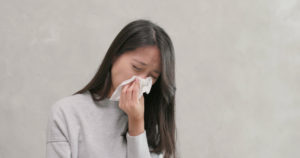Allergy to Chlorine?

The swimming season is in full swing and most public and private swimming pools are attracting swimmers of all ages and of all skill levels. For most individuals, swimming is one of the most pleasurable recreational avenues offered in the summer. For others, swimming offers an effective workout option without putting undue pressure on one’s joints.
Despite the popularity of swimming, a small percentage of individuals may experience adverse reactions while in a pool or after coming out of the pool. Some individuals experience itchy skin and rashes while others notice an increase in upper and lower respiratory symptoms. The question is: Is the chlorine in the water the culprit?
Chlorine is a chemical added to water in swimming pools in order to kill the bacteria that can grow in such water. Chlorine also oxidizes suntan oils, other body oils, cosmetics, leaf mold, bugs, urine, sweat, and other human bodily waste. Chlorine is not an allergen because it does not stimulate the immune system to produce proteins which then cause allergic symptoms. Chlorine is instead considered an irritant. As an irritant, chlorine may cause undesirable side effects on the skin and respiratory system. It is similar to other irritants such as perfumes, colognes, strong scents, pollution, and organic dusts. These irritants may also cause skin and respiratory symptoms that may be confused for allergy symptoms, but when it comes down to it, the symptoms are due to the irritating effect of the chemicals, dusts, or particulates, and not an allergic reaction to them.
In sensitive individuals, chlorine can result in a type of irritant contact dermatitis (ICD), especially if the concentration of chlorine in the pool is high.
Symptoms of irritant contact dermatitis may include:
- Excessive dryness of the skin
- Redness of the skin
- Itching of the skin
- Flakiness, fissuring, and/or scaling of the skin
- Hives (i.e., urticaria) – Raised blotches or “welts” with clear margins
Treatments of irritant contact dermatitis include:
- Washing with fresh water as soon as coming out of the pool
- Liberal application of emollients (i.e., moisturizing lotions)
- Mild topical corticosteroid creams or ointments
- Antihistamines to relieve itching of the skin
Patients with a history of respiratory disorders [i.e., asthma, chronic obstructive pulmonary disease (COPD)] may experience more of a flare-up of both the upper and lower respiratory symptoms listed below when exposed to chlorine in a pool.
Upper Respiratory Symptoms:
- Sneezing
- Itchy nose
- Runny nose
- Nasal congestion
- Post-nasal drip
- Itchy throat
- Itchy eyes
- Watery eyes
- Redness of the eyes
- Sinus congestion
- Sinus headaches
- Coughing
Lower Respiratory Symptoms:
- Chest tightness
- Coughing
- Shortness of breath
- Wheezing
Even though the above upper and lower respiratory symptoms may be seen in anyone exposed to chlorine, these symptoms are more common and more prominent in patients with inadequately controlled allergic rhinitis (i.e., hay fever) and/or asthma.
Treatment of Upper Respiratory Symptoms: The treatment of the upper respiratory symptoms caused by chlorine exposure may include oral antihistamines, oral decongestants, nasal corticosteroids, nasal antihistamines, nasal anticholinergics, ocular antihistamines, ocular decongestants, and/or ocular mast cell stabilizers.
Treatment of Lower Respiratory Symptoms: The treatment of the lower respiratory symptoms caused by chlorine exposure may include an inhaled bronchodilator and/or an inhaled corticosteroid. The inhaled corticosteroid is used to prevent and control airway inflammation.
Prevention of Chlorine-Induced Symptoms: Choosing a swimming pool with less of a concentration of chlorine may help prevent or mitigate the severity of symptoms that occur in individuals who are sensitive to the effects of chlorine.
The board certified allergy specialists at Black & Kletz Allergy have expertise in diagnosing and treating chlorine sensitivity as well as all types of irritant reactions. In addition, we also treat all types of allergic, asthmatic, and immunologic conditions. The allergists at Black & Kletz Allergy treat both pediatric and adult allergy and immunology patients and have been practicing in the Washington, DC, Northern Virginia, and Maryland metropolitan area for more than 50 years. Black & Kletz Allergy has offices in Washington, DC, McLean, VA (Tysons Corner, VA), and Manassas, VA. All 3 of our offices have on-site parking. For further convenience, our Washington, DC and McLean, VA offices are Metro accessible. Our McLean office location offers a complementary shuttle that runs between our office and the Spring Hill metro station on the silver line. For an appointment, please call our office or alternatively, you can click Request an Appointment and we will respond within 24 hours by the next business day. If you suffer from irritant reactions to chlorine or any other irritant, or have allergies or asthma, we are here to help alleviate or hopefully end these unwanted symptoms that have been so bothersome, so that you can enjoy a better quality of life. Black & Kletz Allergy is dedicated to providing the highest quality allergy, asthma, and immunology care in a compassionate, relaxed, and professional environment.

 We love our pets. Pets are very important to humans. They fulfill all types of psychological and social needs that people desire including happiness, self-worth, and companionship. Unfortunately, some individuals cannot experience the joy of owning a pet because they have allergy or
We love our pets. Pets are very important to humans. They fulfill all types of psychological and social needs that people desire including happiness, self-worth, and companionship. Unfortunately, some individuals cannot experience the joy of owning a pet because they have allergy or 
 Is it possible to be allergic to exercise? Well, not really, however, exercise can cause the body to exhibit the signs and symptoms of allergies! We are also not talking about an excuse not to exercise! The mechanism by which exercise causes “allergy” symptoms is not completely understood but it seems to be related to an exaggerated cholinergic response to the warming that occurs with exercise and not due to an allergy at all. There is an increased level of histamine during and or following exercise in many of the conditions associated with this phenomenon. The severity of the “allergic” symptoms can range from mild to severe and in some cases they may be life-threatening. As a general rule, patients should stop exercising at the first sign of an “allergic” or asthmatic reaction. It may be recommended by a board certified allergist that individuals with any of the following conditions carry an epinephrine self-injectable device (i.e., EpiPen,Auvi-Q, Adrenaclick). It should also be noted that if one uses such as device, he or she should go immediately to the closest emergency room. Below are some examples of conditions where exercise causes symptoms that mimic allergies:
Is it possible to be allergic to exercise? Well, not really, however, exercise can cause the body to exhibit the signs and symptoms of allergies! We are also not talking about an excuse not to exercise! The mechanism by which exercise causes “allergy” symptoms is not completely understood but it seems to be related to an exaggerated cholinergic response to the warming that occurs with exercise and not due to an allergy at all. There is an increased level of histamine during and or following exercise in many of the conditions associated with this phenomenon. The severity of the “allergic” symptoms can range from mild to severe and in some cases they may be life-threatening. As a general rule, patients should stop exercising at the first sign of an “allergic” or asthmatic reaction. It may be recommended by a board certified allergist that individuals with any of the following conditions carry an epinephrine self-injectable device (i.e., EpiPen,Auvi-Q, Adrenaclick). It should also be noted that if one uses such as device, he or she should go immediately to the closest emergency room. Below are some examples of conditions where exercise causes symptoms that mimic allergies: The esophagus is a tubal structure that propels food from the throat into the stomach through rhythmic contractions of the smooth muscles in its walls. A thin mucus membrane lines the insides of its lumen. Eosinophils are type of white blood cells that have some role in combating certain parasitic infections. Eosinophils can also cause damage to tissues when they are accumulated in excess, due to a chronic inflammatory process.
The esophagus is a tubal structure that propels food from the throat into the stomach through rhythmic contractions of the smooth muscles in its walls. A thin mucus membrane lines the insides of its lumen. Eosinophils are type of white blood cells that have some role in combating certain parasitic infections. Eosinophils can also cause damage to tissues when they are accumulated in excess, due to a chronic inflammatory process. Generalized pruritus (i.e., generalized itching) is not an uncommon condition and can be quite maddening to the individual suffering from it. It may be associated with
Generalized pruritus (i.e., generalized itching) is not an uncommon condition and can be quite maddening to the individual suffering from it. It may be associated with  There are disease states where medications taken by mouth do not offer enough benefit in either relieving symptoms, stopping the progression of a condition, or preventing complications of a disease. In these instances, medications may need to be administered by means of the parenteral route, such as using a needle or catheter to infuse the medication.
There are disease states where medications taken by mouth do not offer enough benefit in either relieving symptoms, stopping the progression of a condition, or preventing complications of a disease. In these instances, medications may need to be administered by means of the parenteral route, such as using a needle or catheter to infuse the medication. Hay fever is the common name for
Hay fever is the common name for